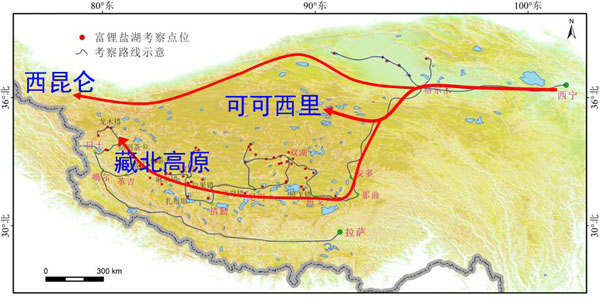Qinghai-Tibet Plateau is extremely rich with salt lake resources and it is famous for its strategic resources such as K, Li, Rb, Cs, and U. Based on the difference in resource demand in different periods, the emphasis on the exploration and development of different elements in salt is changing. In the last century, sufficient research has been done on B resources in Tibetan salt lakes and K, B resources in Qaidam Basin. Relying on the K resources in the salt lake, theQaidam Basin has become the most important production base of potash fertilizer in China, ensuring the security of agriculture of the country. In recent years, due to the importance of Li in the country’s new energy strategy, research and development of Li in salt lakes has attracted great attention. At the same time, more and more attention has been paid to the abundant Rb and Cs resources in the salt lake of the Qinghai-Tibet Plateau.
Qinghai Institute of Salt Lake carried out a new round of scientific expedition to systematically inspect the Rb and Cs resources of more than 50 lithium-rich salt lakes in Tibet. The research has been carried out on Rb and Cs in the salt lakes of Qinghai-Tibet Plateau, Nanyishan oilfield water, salt lake potassium chloride products and lithium tail salt of lepidolite extraction, and the separation and extraction of Rb and Cs have been achieved to a certain extent. In the study of brine evaporation and Rb, Cs extraction from Lagocuo Salt Lake in Tibet, Rb and Cs can be concentrated from 10 mg·L-1 to 594 and 1068 mg·L-1, respectively. 45.7% of Rb and 99.5% of Cs in the concentrated solution were extracted by extraction method; 57.2% of cesium in the concentrated solution was extracted by one-time adsorption method.
The next step will be to carry out larger-scale sampling and analysis work to further clarify the spatial distribution characteristics of Rb and Cs in different types of brines, reveal the geochemical processes of migration, enrichment and transformation of Rb and Cs in salt lakes, and clarify the different mechanism between Rb and Cs. At the same time, strengthen the investigation of Rb and Cs resources in underground brine and deep hydrothermal fluids, and conduct a comprehensive evaluation of the resource potential of these two elements. The Institute will also promote research on new technologies for Rb and Cs extracting from brine. By focusing on the coupling process of flotation, adsorption, extraction, and other methods, to achieve a Rb extraction rate of more than 70% in the concentrated solution, and obtain rubidium and cesium salt compounds with a purity of 90% in the aim of developing the comprehensive utilization process of Rb, Cs, and other elements, exploring the low-cost way to extract Rb and Cs, and accelerate their industrialization process.

